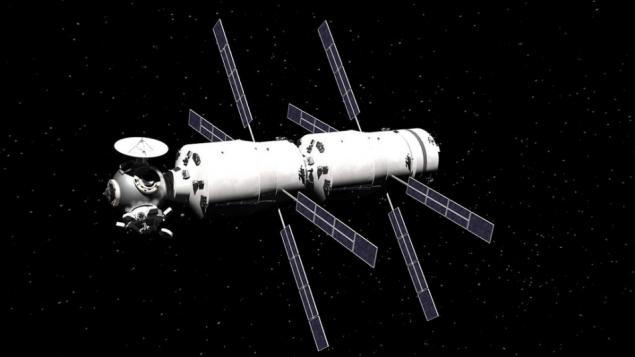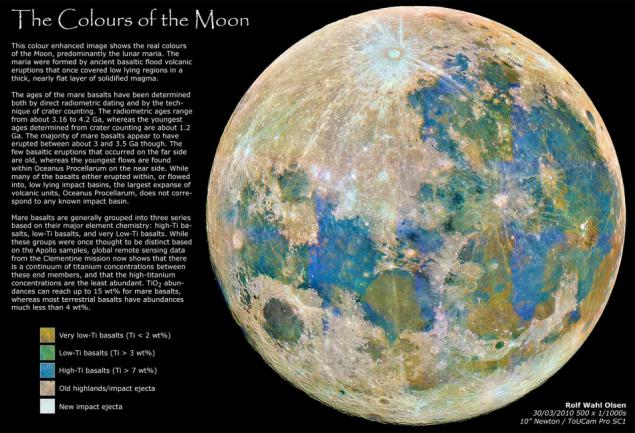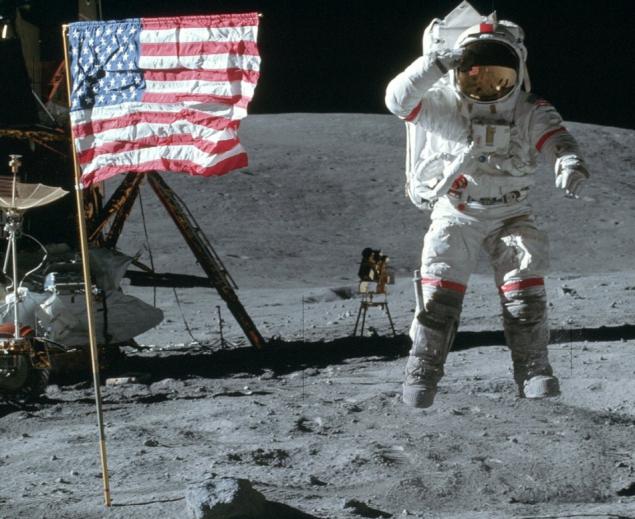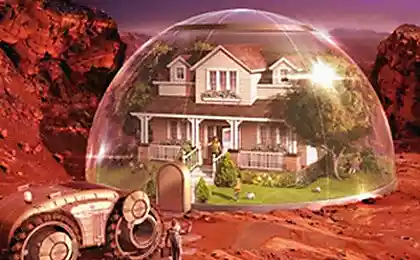1543
On the priorities of space expansion

June 11 successfully completed кампания Fundraising for the design of a manned mission flyby of Mars and Venus. I have for some time wanted to write about where and what better than to fly, but because the very critical attitude to obletnym missions, postponing publication to criticism not inadvertently interfere with the overall useful idea. And now, joining in the congratulations and wish you every success of the project development team, we can speculate without interference, which object is the most popular for the manned space expansion?
As the opening goal changed h4> 
left - Mars, as seen by the Hubble Telescope, right - like Mars, astronomers have seen the end of the XIX century i>
The answer to the question "where to go" was the simple fiction for early and mid-twentieth century - any goal was attractive because of lack of knowledge. The mysterious side of the Moon, covered with eternal clouds, Venus, Mars with its TV - had to fly everywhere. But scientific discoveries turned bitter. On the Moon, there was no atmosphere, Aboriginal or anything interesting except regolith and volcanic rocks. Venus, which represents the past of the Earth is not inhabited prehistoric women, and the clouds turned out to be a real hell with a temperature of 500 ° C and a pressure of 100 atmospheres. Mars, which was to be a wise ancient civilization struggling with a lack of water and oxygen, or, in extreme cases, its ruins, was dead, and even probes found in Cydonia sphinx with pyramids appeared as channels, an optical illusion. It is difficult to say something to man, called the lunar program, in which people are six times landed on another celestial body, the offensive word "flagovtyk." Indeed, people have gone to the moon and forty years are not motivated to come back.
In the twenty-first century, the situation is not much better. We have learned a lot through automated missions, but in the world of those who work in the industry or are simply interested in space, there is no consensus about the goals of the next "giant leap" of humanity. The debates and discussions defended some of the most promising targets:
Luna. B> For the lunar base acts , such as new director European Space Agency Johann-Dietrich Werner. No matter how useful the ISS, it is not eternal, and at the May conference Werner suggested the idea base on the back side of the moon. Mars. B> This is the ultimate goal in today's plans NASA, and mission to the Moon and asteroids are considered only as preliminary steps. In addition to the State Space Agency Mars as the main objective is considering Mars Society, Robert Zubrin, also declares a desire to send people to Mars one way the company Mars One (but may be rogues) Obletnye mission. In 2013, the millionaire space tourist Dennis Tito presented a draft Inspiration Mars - obletnoy mission to Mars lasting 500 days in 2018. Now, in 2015, it is clear that this project will not fly - the money yet, and preparation time no longer exists. But new ideas are put forward now and will appear in the future. Orbital stations. B> In fact, the only successful project is now working - ISS flying for 15 years, and it is continuously working people visiting fly to the Chinese, "Tiangong". In addition to the Earth's orbital station offers ideas and Lagrange points in the orbit of the moon.
The Curse obletnoy mission h4> The so-called obletnaya mission is that the ship, starting with the low-Earth orbit, flying past the target object without leaving its orbit. Sometimes you manage to visit several sites, changing the orbit of the planets gravitational maneuvers goals. Typically, the objectives selected neighboring planet Earth - Mars, Venus. These projects are designed to USSR and the USA , in 2013 a lot of fuss about the project Tito, and now to develop a project of such a mission enthusiasts want astronautics from Russia.

The project obletnoy mission 2021-2023, it is proposed to use the ship on the basis of the European truck ATV i>
But any obletnoy mission there is a huge problem, which means solutions must submit a development team. In simple terms, obletnaya mission - is sitting for months under difficult and dangerous conditions of a small ship for a few hours flyby target planet. That in such circumstances a person can do? Photograph planet from orbit, and click a few buttons, including scientific instruments? But this has done machines, which weigh less, do not need food, water, oxygen and hygiene products, can fly for years in hibernation, have literally iron nerves, and their death is not a tragedy.

The Inspiration Mars mission would have to look at the night side of Mars, even dreary i>
Why do we send people if the machines will be easier, cheaper, and better cope with the task? The development team obletnoy mission is to come up with some high and important task, for which it needs people, and their risks and inconveniences are somewhat justified. At the same time the ideas that were put forward, not stand up to scrutiny:
Get the new scientific information Study of effects on humans of prolonged space flight Prestige
Road orbital stations h4> 
station "Salyut-7» i>
Orbital stations were already relatively long time - "Salyut-1" went into space in the spring of 1971. It was created as an asymmetric response to the lunar program of the US, but the idea has survived competitor and was very helpful. It allowed people to the orbital station located in space, not days and months. The space station is being set of physical, biological, medical and other experiments. More recently, there were projects private space stations . But from the perspective of space expansion space station - it is a staging post, not the final goal. Space is empty and, unlike the planets orbiting station can not use local resources. So now enthusiasts of space stations can not answer the question of why space station on a low earth orbit. Perhaps that is why there is a bright and notable projects of new orbital stations. Yes, sometimes talking about the station in one of the Lagrange points, but again, it is usually considered as a staging post on the way to the moon.
The two finalists h4> In the end, we were left with you two finalists - the Moon and Mars. In recent months, I gradually came to the conclusion that the purpose of the twenty-first century should be the moon. Let go of Mars robots, and even landing there, in my opinion, is irrational. But the attempt to build a base on the moon, though visitors should, and I will try to argue their opinions.
The first argument. Flight time h4> 
The distance to the moon on a scale speed of light i>
Before the Moon can be reached in three days. Mars need to fly for about six months. This simple fact on our current level of technology is the most important. With the Moon possible emergency evacuation from Mars - no. From 9 manned missions to the moon one ( Apollo 13 ) faced a deadly accident, but features the lunar module was enough to maintain the life of astronauts at the time of return. A similar accident on the way to Mars - certain death. A technique is never secure 100%.
Distance to the Moon - roughly one light-seconds. You can easily keep in touch in real time and to synchronize the work of scientific instruments. The distance to Mars varies from 3 to 22 minutes of light. If you want to "call" on Mars, then the other person will respond to you in the best case after 6 minutes, and in the worst case by 40. The only option acceptable communication - e-mail. And every 26 months for about two weeks, when between Earth and Mars is the sun, the connection is not possible at all.
In addition to communication, the duration of the flight time makes qualitatively different requirements for ships. For two weeks, the flight Earth-Moon-Earth lack of non-renewable water supplies, food, oxygen and electricity. Flight to Mars will not be able to do without a closed life-support systems, which at times more difficult.
The second argument. Nothing comes for free h4> Look at the map characteristic velocity (delta-V), which must be expended to move between the bodies of the solar system:

The white triangle indicates the possibility of aerodynamic drag of the atmosphere. At the level of the scheme all it seems simple, and the stock seems to be comparable to the characteristic speed for the road to the Moon and Mars. However, aerodynamic drag is not free. The aerodynamic shield and landing system has mass. And not the fact that the landing system for the Mars using "free" inhibition of the atmosphere, it will be easier than the system of landing on the moon. For example, the lander for a soft landing of the 900-pound rover Curiosity weighed 2, 4 tons. The landing station of the Moon with the same initial mass позволит put about 1, 5 tons of the surface, which is enough for a similar rover and lander.
third argument. No luck with the atmosphere h4> 
The dust on the solar panels of the Mars rover Spirit i>
In general, the atmosphere of Mars is surprisingly inconvenient characteristics. Pressure on the surface of Mars compared with the pressure at an altitude of about 30 km above the Earth, and the atmosphere is 95% carbon dioxide. On the one hand, the atmosphere is too thick to ignore it during takeoff or landing, on the other hand, it is too sparse to even walk on the surface without a spacesuit. It is difficult to use for something useful. Yes, it can fly specially designed apparatus, for example, it can attempt to use the plant growth and the production of oxygen, but it is difficult. The atmosphere is dense enough to keep warm, and despite the fact that on Mars there is no lunar extreme heat conditions are not much better. The range is from -140 ° to + 20 °, alas, is comparable to the lunar -170 ° - + 110 °. Martian atmosphere also allows to form dust storms on a planetary scale, which will interfere with the operation of solar cells and cover all the equipment dust. On the Moon dust is also unpleasant, it is abrasive and will require increased attention in the development of rubbing parts mechanisms. But the whole atmosphere of Mars did not make it prettier moon, and perhaps vice versa.
fourth argument. On water and resources h4> In recent years, the water show on the entire solar system from Mercury to Saturn's moons. It is regrettable, but these findings did not spur efforts to colonize - other conditions remain critical uncomfortable. Water is on Mars and on the moon, and here and there a lot of it. Maybe on Mars it easier to obtain, it has a fairly large and ice in concentrated amounts, but in the craters at the poles of the moon still really no down may produce water there would be no more difficult.

blue - water, green - brightness in the infrared, red - mineral пироксен
In terms of geology of Mars Moon richer. He had a long and interesting history, is almost certain that once it was literally an ocean of liquid water. The history of the moon poorer, on its surface there was liquid water on it and could not find sedimentary rocks found in abundance on Mars. But in terms of colonization of the most important is the issue of economic use of local resources. And here, it seems, the Moon is not far behind Mars. For example, in исследовании 2014 argued that plants grow quite successfully in the Martian and lunar soil. Yes, of course, the study used simulations of soil, but the surface of Mars is known to us well enough thanks to the robots, and soil from the Moon brought a lot to be able to hope that the simulators will be accurate enough.

The map prevalence of iron oxide on the Moon i>

Different types of basalts on the Moon i>
The argument fifth. On Science h4> And on the Moon and on Mars can be carried out very interesting research. On Mars, it will be very interesting story - it loses water and oxygen, whether it lives, and whether to save it now? On the Moon, you can spend a wider range of research. In addition to exploring the Moon itself, it is possible to build telescopes that, working together with the earth, able to create an interferometer with a giant database. You will be able to easily see small planets in neighboring star and withdraw their range. Who knows, maybe the stone planet with an abundance of water and oxygen are as common as gas giants, which we can see now? In addition, the Moon could become a testing ground colonization. How to build a base? How to organize in her life support? How to use local resources? All this can effectively learn on the moon. As for Mars - its history is already successfully exploring robots, and when we learn to build colonies on other celestial bodies, and his turn will come.

to color the surface of the moon. The image was obtained from 53 pictures, processed three spectral filters Imaging artificial, exaggerated colors i>
The argument sixth. About prestige h4> 
It is believed that the mission to Mars would be much more prestigious lunar program. I disagree. The fact that the lunar program of the twentieth century was, in fact, jump higher than his head. Yes, six expeditions landed on the moon, but the three of them spent the entire day on the surface, and the remaining three - only three days. This is a very short time. On the Moon, there was only one professional geologist. Even machines not yet landed on the poles, and no one makes a deep drilling lunar soil. Indeed, repeated the American lunar program interesting and prestigious. But for a long time to come, to build a base, to do science in a big way - it would be really a giant leap forward.
Oh where, what and how you can do on the moon - in the next section.
In the tag «мысли the future of space exploration » reflections on the present and future of space exploration.
Source: geektimes.ru/post/252302/
The dream to live near the sea will carry out house of the future
11 Old-fashioned habits relationship which we sorely missed


































